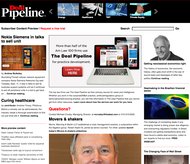The new venture comes as Sony faces pressure from the activist shareholder Daniel S. Loeb to increase returns from its entertainment divisions. The move promises to reboot a film and television label that until the late 1990s was operated as a fully staffed studio, run in parallel with Sony’s Columbia Pictures unit.
“On the poetic side, I’m a film buff, and I like being with something historical,” Mr. Rothman said of his reason for reviving the unit, which will be called TriStar Productions, rather than starting from scratch. At the same time, he said, the prospect of significant investment from Sony, and TriStar’s good will within Hollywood’s creative ranks, give the rebuilt studio an edge.
Mr. Rothman, who expressed support for Sony’s management, declined to say how much money Sony would invest in the studio. He and company executives said it was expected to make four films a year, and to split its activities evenly between film and television. Mr. Rothman said he would have an equity stake in the venture and was open to outside investment but expected to begin operating with Sony’s money.
In a statement, Sony Pictures Entertainment said Mr. Rothman would report to Michael Lynton, who is chief executive of that unit, and Amy Pascal, who is co-chairwoman.
Speaking separately on Thursday, both Ms. Pascal and Mr. Rothman said negotiations toward the TriStar venture began well before the first round of criticism by Mr. Loeb. Earlier this year, Mr. Loeb acquired a stake in Sony and began pressing the corporation’s managers to spin off its entertainment division, as a way of pressing it for better returns. Sony Pictures suffered an embarrassing flop this summer in “After Earth,” a science fiction film that starred Will Smith and his son Jaden.
But it did better with two comedies, “This Is the End” and “Grown-Ups 2,” and is looking toward another science fiction film, “Elysium,” for a boost.
“Elysium,” which stars Matt Damon and is backed financially by Media Rights Capital and QED International, is being released under the TriStar brand, which in recent years has been used largely for smaller films or pictures acquired from outside financiers.
Mr. Rothman, who has a reputation for controlling costs, said he expects to staff the company efficiently but said that under the arrangement, he will operate without formal limits on the size or type of films he might make.
Ms. Pascal said early conversations with Mr. Rothman had centered on a venture that might provide the smaller, artier films for which Mr. Rothman became known when he started Fox Searchlight for News Corporation and its 20th Century Fox unit. But ultimately, she said, the partnership was crafted to allow for more scope. “We want to make movies that make money,” she said.
Founded in 1982 as a joint venture among Columbia, HBO and CBS, TriStar — initially Tri-Star Pictures — grew with the explosion in home video revenue. It was eventually merged with Columbia in Columbia Pictures Entertainment, which in 1989 was acquired by Sony. Its peak moments included the release of “Jerry Maguire,” which had five Oscar nominations in 1997, and of “Terminator 2: Judgment Day,” which took in about $520 million around the world after opening in 1991.

Article source: http://www.nytimes.com/2013/08/02/business/media/sony-hires-rothman-to-head-revived-tristar-unit.html?partner=rss&emc=rss

